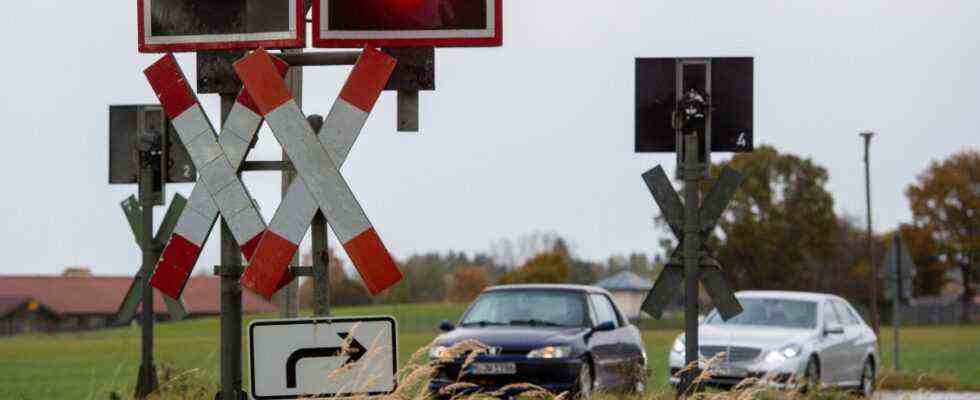In mid-October there was another accident in Neukirchen am Inn in Lower Bavaria. A passenger train crashed into a truck at a level crossing, luckily no one was injured, but the property damage amounted to around one million euros, according to the police. Just a few days later, a similar incident occurred near Nieder-Ofleiden in Hesse: There, too, a train collided with a truck, the driver was trapped in his vehicle and seriously injured. Such accidents, some of them serious, happen again and again. Deutsche Bahn, the Federal Police responsible for the safety of railway lines and other actors therefore regularly try to point out the special dangers at level crossings.
How often do accidents occur at level crossings?
In Bavaria alone, a little more than 50 accidents at level crossings were counted in 2020, eleven of them with fatal results, explains the Bavarian Railway Company (BEG), which is responsible for local rail transport in the Free State. Nationwide, there are “serious accidents at level crossings almost every week,” warns the ADAC.
Who is to blame for the accidents?
“Almost all accidents at level crossings are due to misconduct by drivers or pedestrians,” says Jürgen Hildebrandt, head of the traffic, technology and environment department at ADAC Nordbayern. The main causes are mostly ignorance of the rules of conduct, inattention and recklessness. In addition, trains have a long braking distance. For example, a (relatively light) regional train that travels at 60 kilometers per hour only comes to a stop after almost 100 meters, according to ADAC, despite an immediate emergency braking. With significantly heavier trains and higher speeds, the braking distance can be up to 1000 meters according to BEG and Deutsche Bahn.
How can the accidents be avoided?
“Every accident is one too many,” says Axel Hennighausen from the railway operator Agilis. Drivers should approach every level crossing with particular care. Every level crossing is announced to the motor vehicle traffic with white and red beacons – first 240 meters before, then 160 meters and finally 80 meters before the crossing. The St. Andrew’s Cross is immediately before the crossing point. What many do not know: It does not simply mark the level crossing, but rather contains clear instructions, explains Hennighausen: Rail traffic has priority. In addition, trains warn road users with whistling signals at level crossings that are not technically secured.
How should road users behave at the level crossing?
It is important, says ADAC expert Hildebrandt, to always be ready to brake and to approach a level crossing at a maximum of 50 kilometers per hour. “Do not overtake and look out over the railway line on both sides,” he advises. In addition, the following applies: “Stop immediately if a train approaches the open crossing.” Because the cause of the sometimes serious accidents are not infrequently time pressure “and the misconception that the situation is under control”. In addition, many people become less aware of risk if nothing has happened in the event of repeated misconduct.
What else should you pay attention to?
You should stop at barrier crossings as soon as the red flashing light comes on, says Hildebrandt. “And not only when the barriers come down.” The reverse applies after the train has passed: “Do not continue until the red flashing light has gone out and the barriers are fully open.” Also important: from the first warning beacon, i.e. 240 meters before the actual level crossing, overtaking is prohibited. “Please stick to it strictly,” says the ADAC.
The truck driver was seriously injured in this accident in Nieder-Ofleiden in Hesse.
(Photo: Federal Police Inspection Kassel / dpa)
What should you watch out for with half barriers?
Half-barriers only block off part of the width of the lane – and sometimes tempt drivers, motorcyclists and cyclists to bypass them. Even pedestrians often ignore the barriers and try to scurry quickly across the tracks. But even that can be fatal or at least lead to serious injuries, warns the BEG: “Never climb over barriers and run or drive past them.”
What could the legislature do?
According to ADAC, the number of level crossings has been steadily reduced over the past few decades and has even been more than halved in the Deutsche Bahn network since 1950. Nevertheless, according to the BEG, there are still almost 3300 level crossings in Bavaria alone, around every second of which is unrestricted. The ADAC demands that at least the protection by whistling should no longer be allowed. “The noise insulation of modern motor vehicles largely shields audible signals from the rail vehicles,” says a position paper. The club also recommends painting a (solid) stop line or a (dashed) waiting line at the level crossings on the street. These lines would also make the priority of rail traffic clear to road users.
These rules apply at the level crossing.
(Photo: Deutsche Bahn)
What if a traffic jam has formed?
If several vehicles approach a level crossing in a column, you should keep a safe distance from the vehicle in front, advises the ADAC – so that no one has to stand on the level crossing in the event of a traffic jam. The same applies if a traffic jam has formed on the other side of the rails: Then only drive off when the vehicles start on the other side and there is enough space there.
And what should you do if the car breaks down on the level crossing?
The ADAC advises you to leave the vehicle and the level crossing immediately. And then immediately make an emergency call on 112.

